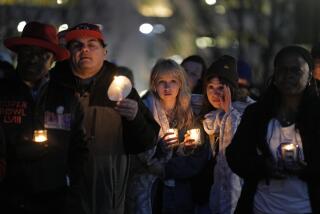Op-Ed: Kansas, the KKK and hate without end
The news that a former grand dragon of the Ku Klux Klan is suspected of shooting and killing three people near Jewish community centers in Kansas seems at first glance like a disparaged past flaring briefly into the present. Americans like to imagine that the KKK belongs to a long-gone South and anti-Semitism to a distant 20th century. Sadly, this better reflects a naive faith in the nation’s history of religious tolerance than the realities experienced by many religious minorities. Although the KKK has evolved and its membership has dwindled, it remains part of an American legacy of religious intolerance.
A central tenet of U.S. nationalism rests on a notion of welcoming huddled masses, but the idea of American exceptionalism also runs deep. When Americans have imagined their country’s uniqueness as defined racially, religiously or culturally, those outside those parameters are immediately suspect. Sadly, religion has often served as the catalyst for prejudice.
The Puritans sought to build a “city upon a hill,” which necessarily excluded “heathen” Native Americans. In the early 19th century, Anglo Protestants viewed Irish Catholic immigrants as anti-secular subversives, burning a convent school in the Boston area in 1834 and sparking riots in 1844 that reduced some Philadelphia neighborhoods to combat zones. In this century, a combination of right-wing politicians, conservative donors and professional Islamophobes often portray Muslim Americans as potential fifth columnists seeking to spread sharia law throughout the land.
As fantastic as such suspicions appear from afar, we cannot underestimate their reality among those who complain that “this is not the nation in which I was raised.” As the nation continues to move away from a white and Christian norm — and especially during economic downturns — it becomes tempting to blame “outsiders” for the change from how “things used to be.” Defining life as a zero-sum game, the “other’s” success must necessarily come at the expense of “our” opportunity in a land “our ancestors” built.
The KKK has manifested this dynamic since it emerged in the South in the immediate aftermath of the Civil War. Targeting newly freed blacks in an effort to maintain white supremacy, the KKK terrorized the region. However, passage of the Ku Klux Klan Act of 1871 and, later, the institutionalized segregation of Jim Crow laws led to the Klan’s rapid fading popularity.
The 20th century saw the return of a KKK that may have drawn inspiration from its past in the Reconstruction South and now sought prominence as a modern national organization. Further agitating already inflated fears of East European immigration in the 1920s, its leadership around the country seeded branches called “klaverns” (part of an invented vocabulary exalting Klan secrecy and exclusivity). Although blacks suffered again at the hands of the revived Klan, immigrants became new targets.
The Klan of the 1920s successfully channeled such sentiments into a national organization that claimed 4 million members from the Carolinas to California. Societies boasting the KKK name emerged on American university campuses at a time when perhaps 40% of fraternities limited membership to “Aryans” and “Caucasians.” Anaheim — future home of Disneyland — boasted such a public and political Klan presence that it was nicknamed “Klanheim.” In 1925, the imperial wizard led tens of thousands of members in a parade down Washington’s Pennsylvania Avenue.
The KKK’s nativism welded racism to religious prejudice to create a powerful cudgel aimed at East European immigrants in general and Jews in particular.
This second generation of the Klan dissipated in a welter of infighting and scandals, even as most Americans rejected its message and ostracized its members. However, the civil rights movement of the 1960s spurred a third emergence. Never reaching the popularity of the previous incarnations, this one nevertheless wrought havoc, especially on black communities.
The Southern Poverty Law Center estimates that the Klan now attracts only about 5,000 to 8,000 members. Their motivations prove more theologically and ideologically mixed than before, but they nevertheless remain potent.
Today, Jews report the highest number of religious hate crimes, but they are not alone. Since the 9/11 attacks, reports of religious hate crimes committed against Muslim Americans have skyrocketed, from the second-least reported to the second-most reported. The killing of six Sikhs in Oak Creek, Wis., in 2012 and similar assaults remind us that race, religion and nationalism continue to motivate hate crimes.
The religious pluralism evident in the United States testifies to the remarkable accomplishments the nation has made in promoting tolerance and inclusion. However, the recent sad news from Kansas reminds us that a pernicious current promoting racial, religious and national exclusivity continues to electrify an active third rail of American history.
Peter Gottschalk is a professor of religion at Wesleyan University and the author, most recently, of “American Heretics: Catholics, Jews, Muslims, and the History of Religious Intolerance.”
More to Read
A cure for the common opinion
Get thought-provoking perspectives with our weekly newsletter.
You may occasionally receive promotional content from the Los Angeles Times.










